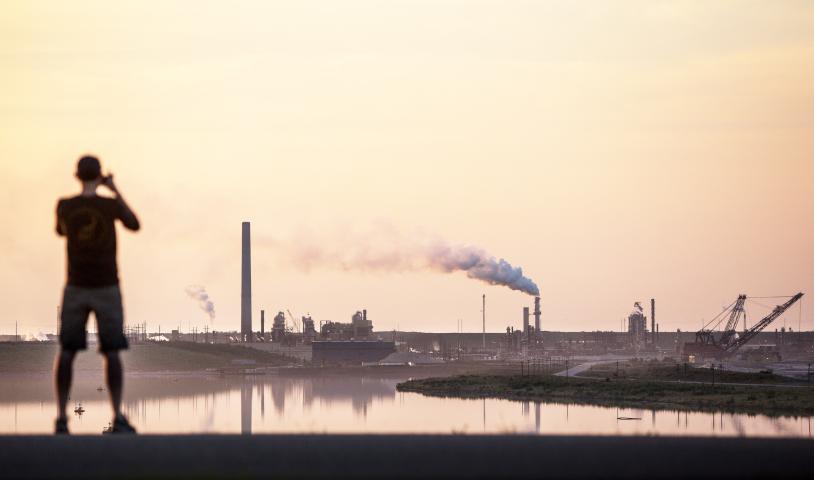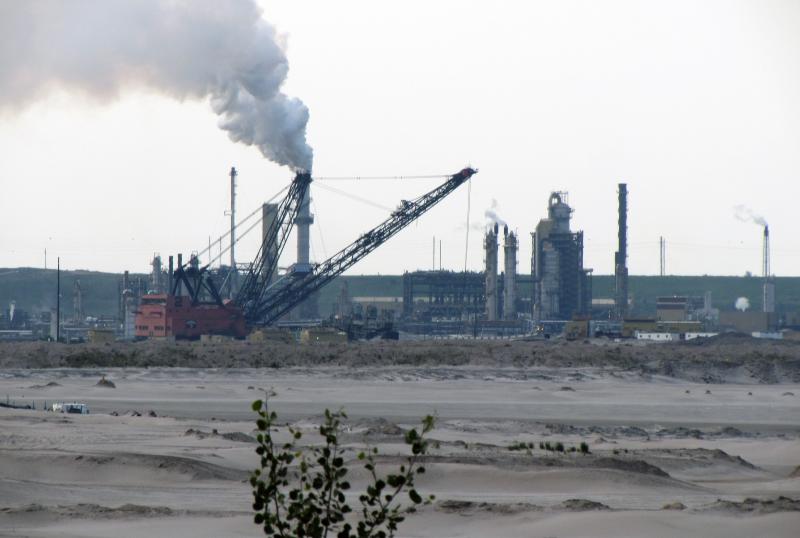The Belly of the Beast: My Trip to the Tarsands
Thursday, August 28, 2014
August 28, 2014
This past June I paid a visit to the infamous tarsands of Alberta, where once-pristine Boreal Forest is labelled “overburden” and then stripped away to reveal the source of the world’s dirtiest oil: bitumen. The problem with bitumen is that it no more resembles conventional crude oil than a lump of molasses. It takes enormous amounts of water and energy-intensive processes to turn that sticky, tarry substance into something that could flow in a pipe. That’s why they call it the tarsands—this stuff was once used to tar roofs for weatherproofing. The oil industry’s insistence in rebranding it “oilsands” reflects how little they worry about what we sacrifice to get at this stuff.
I arrived at the newly-opened Fort McMurray International Airport—a giant swanky declaration of belief in the future of the local oil industry. T-shirts reading “I love Fort Mac, I love oil” were the tourist kiosk’s way of reminding me where I was.
This far North, the evening light showed no intention of fading despite my evening arrival. It wasn’t long before I was barrelling down the busy highway north of Fort Mac, sharing the road with fleets of dusty pickup trucks and heavy equipment rigs. Everyone is moving fast, and depending on the time of day, in one direction. The sweet, acrid smell of oil production began to seep in the car window as we got closer to the production site itself. One fast turn over the brow of a hill and a large lake opened out before me. In the far distance I could see a thick column of smoke rising from a tower of hulking steel. I felt a little dizzy as I processed the fact that the giant lake before me was toxic waste waiting to settle.
Having grown up in Ireland, it was only then that I realised I have never really known heavy industry. I thought I knew of pollution, of waste storage, of health-hazard zones. Nothing could have prepared me for the sight of the biggest industrial project on earth. The lakes have a sheen that normally only exists under your car when it leaks oil on a wet day. The air has a sulphurous taste that feels abnormal to the face and lungs. Now into the late evening, the summer heat seemed to intensify the oppressiveness of it all. As we rounded the massive lake and got close to the steel hulk, I was shocked to notice yet another tower—this time the worker’s camp for those living on site. I still cannot believe workers are expected to live in that atmosphere every day.
 Next stop was the “giants of mining” tourist park, consisting of an unused collection of the most enormous earth-eating machinery I have ever seen. The industry is proud of its bigness—its ability to conquer and dominate the beautiful countryside of Northern Alberta. I was eager to get some shots of the upgrader across the street and noticed two women sitting at a bench in the park. As I hopped up on the bench to get a better shot, one of them asked what I was up to. I was honest about my reasons for being there and she was honest about how long she had worked at the tarsands. She was also upfront about the income she had earned from those years, but summed it up as follows, “sure you make lots of money here, but you pay for it with your health.”
Next stop was the “giants of mining” tourist park, consisting of an unused collection of the most enormous earth-eating machinery I have ever seen. The industry is proud of its bigness—its ability to conquer and dominate the beautiful countryside of Northern Alberta. I was eager to get some shots of the upgrader across the street and noticed two women sitting at a bench in the park. As I hopped up on the bench to get a better shot, one of them asked what I was up to. I was honest about my reasons for being there and she was honest about how long she had worked at the tarsands. She was also upfront about the income she had earned from those years, but summed it up as follows, “sure you make lots of money here, but you pay for it with your health.”
I noticed a sign on the roadside nearby that proclaimed the surrounding land was “returned to nature”. I walked through the long grass to get some shots of just what the industry meant by this. Small trees lay behind the sign, arranged in even rows. I began to picture what would have been there before the industry had liquidated it. I remembered the stats on reclamation: only a tiny proportion of the tarsands has been “reclaimed” and it looks and functions nothing like before. Leaving the long grass, I started to feel an irritating itch on my lower leg and looked down to notice a rash right where I had brushed the grass. My non-familiarity with polluted environments was again causing a challenge. I thought about the words of my friend in the park.
Rounding another enormous lake, we stopped to get some shots as the setting sun burned orange over the smoke stacks. Beautiful sunsets like this one, perfect for atmospheric photography, are provided for free by the smokestacks billowing particulates into the air. Those last images of the tarsands will always remain with me. I sent one from my camera phone to a friend who replied “is that a beautiful lake behind you, or something I should be scared of?”
This photo I took of the fake birds of prey floating in the water to keep wildlife away spoke a million words to her. There was no way to capture the constant explosions from cannons designed to do the same thing. Such an eerie atmosphere can really only be experienced properly by being there.
I knew before I went to the tar sands that if the exploitation of the tarsands deposits in Alberta continues, we will assure ourselves the pain and damage of runaway climate change. I expected this visit to harden my resolve to speak out against this destructive project. I even expected to be overwhelmed by its size, by its smell. However, of all the experiences I had, the words of that woman in the park left the biggest impact. She reminded me that the tarsands is powered-up not only by copious amounts of freshwater, natural gas and money, but by regular Canadians too. And those Canadians care about their country, and about their health. They can see what the tarsands is: they can feel it in their bodies. But they don’t see another option.
We have to create another option for young Canadian workers before it’s too late.
Eoin Madden | Climate Change Campaigner
